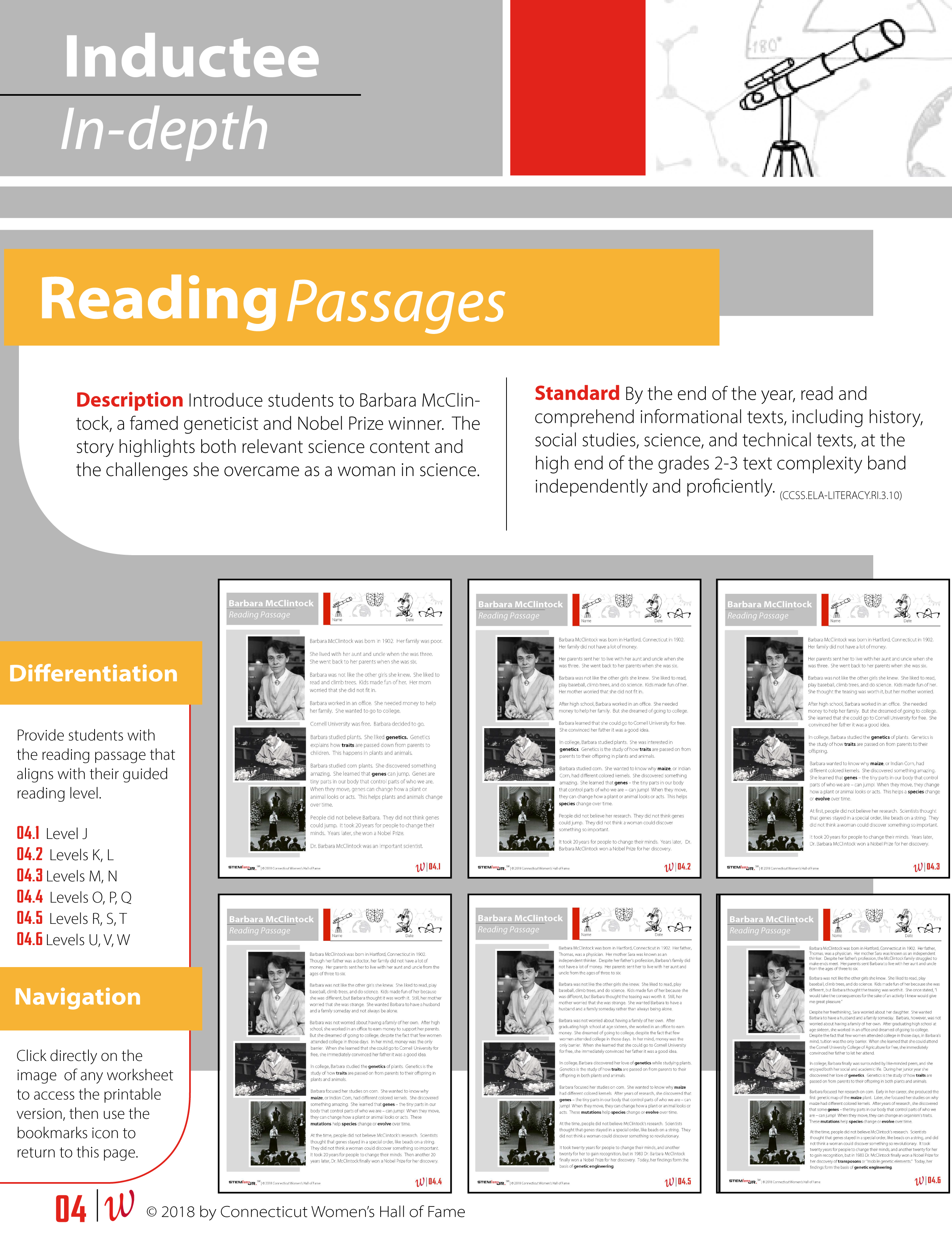Louisa Iacurci
Education Manager, Connecticut Women’s Hall of Fame
TEACHER'S SNAPSHOT
Subjects:
Individuals in History, Science, Women
Course Topics/Big Ideas:
Innovation, Industry, and Economic Growth
Town:
Hartford
Grade:
Grade 3
Lesson Plan Notes
Nobel Prize winner Barbara McClintock was one of the most prominent geneticists of the 20th century. Her studies of genetic mutations in maize (corn) led to her discovery of genes that move from one chromosome to another. Though this radical idea has since formed the basis of modern genetic engineering, it took 30 years for her discoveries to be recognized. McClintock was born in Hartford in 1902. She graduated from Cornell with a B.S. in 1923, an M.A. in 1925, and a Ph.D. in 1927. She produced the first genetic map for maize before the structure of DNA had been identified. In 1970, she became the first woman to receive the National Medal of Science. In 1983, McClintock became the first woman to receive an unshared Nobel Prize for Physiology or Medicine. She was inducted into the National Women’s Hall of Fame in 1986 and the Connecticut Women’s Hall of Fame in 2008. McClintock died in Huntington, New York, in 1992 at the age of 90. She was honored as part of a four-stamp series dedicated to American Scientists published by the United Stated Postal Service in 2005.
ESSENTIAL QUESTION
SUPPORTING QUESTIONS
- What were Barbara McClintock’s contributions to science?
- What is “genetics”?
- Why did it take a long time for McClintock’s contributions to be recognized?
- In what ways are people celebrated and remembered?
- Why are some people remembered and others not?
ACTIVITY
1) Open the activity with a discussion of what scientists do and introduce the compelling question.
2) Students read the appropriate one-page biography of McClintock, based on reading level. (04.1=easiest, 04.6=hardest)
3) Students complete the appropriate one-page close reading worksheet. (05.1=easiest, 05.4=hardest)
4) Students break into groups to complete the word cloud worksheet and create word clouds (page 06.1) reflecting McClintock’s personality traits. Groups create posters of their word clouds.
5) Optional: Students will learn more about genetics by reading the “Heredity & Inheritance” and “Genetic Variation” texts and completing a graphic organizer for each.
6) As a class, students will do a close looking analysis of the award presented to Barbara McClintock as the winner of the National Medal of Science and the stamp created by the U.S. Postal Service to recognize her contributions to science. What do students see? What do they think? What do they wonder? Do they feel like these are good ways to remember and/or recognize Barbara McClintock?
7) Students will circle back to discuss the supporting and compelling questions.
OPPORTUNITIES FOR ASSESSMENT
- Students will create a Venn diagram comparing their own personality traits to McClintock’s. What do students have in common with Barbara McClintock and what is different?
- Students will…
… create their own stamp to celebrate and remember Barbara McClintock as a person and scientist.
OR
… draw a new design for the National Medal of Science.
Students will share their work with the rest of the class and will write or verbally explain the decisions they made while developing their designs. - Barbara McClintock overcame the obstacles of being a woman in science at a time period (1920-1980s) when very few women were research scientists. Find out about another woman from your town or from Connecticut who overcame obstacles. What difference did this woman make in her community, state, or country and how was she similar or different to Barbara McClintock?
RESOURCE TOOL KIT

Barbara McClintock leveled biographies:
04.1 Level J
04.2 Levels K, L
04.3 Levels M, N
04.4 Levels O, P, Q
04.5 Levels R, S, T
04.6 Levels U, V, W
Developed by the Connecticut Women’s Hall of Fame.

Leveled close reading worksheets:
05.1 Levels J
05.2 Levels K, L
05.3 Levels M – Q
05.4 Levels R – W
Developed by the Connecticut Women’s Hall of Fame.

“Heredity & Inheritance” and “Genetic Variation” readings with graphic organizer. Developed by the Connecticut Women’s Hall of Fame.

Word Cloud Worksheet. Developed by the Connecticut Women’s Hall of Fame.

National Medal of Science. Image courtesy National Science Foundation.

United States Postal Service 37-cent stamp featuring Barbara McClintock, issued May 4, 2005. Image courtesy Smithsonian National Postal Museum.
ADDITIONAL RESOURCES
Places to GO
Connecticut Science Center, Hartford
Sacred Heart University’s Discovery Science Center & Planetarium, Bridgeport
Things To DO
Learn some more about genetic traits with this guinea pig activity from the Connecticut Women’s Hall of Fame.
Read a book: Barbara McClintock: Alone in Her Field by Deborah Heiligman, illustrated by Janet Hamlin. Goodreads Press, 2016.
Watch a video about Barbara McClintock from the Connecticut Women’s Hall of Fame (6:36)
Watch a video about genetics (subscription required):
BrainPOP | DNA
BrainPOP | Genetic Mutation
Websites to VISIT
Connecticut Women’s Hall of Fame: Barbara McClintock
National Women’s Hall of Fame: Barbara McClintock
Smithsonian National Postal Museum Women on Stamps: Part 2 Virtual Exhibition
Articles to READ
“Genetics.” Britannica Kids.
“What is Genetics?” OLogy. American Museum of Natural History.
“Press Release: The Nobel Prize in Physiology or Medicine 1983, Barbara McClintock.” The Nobel Assembly of the Karolinska Institute.



